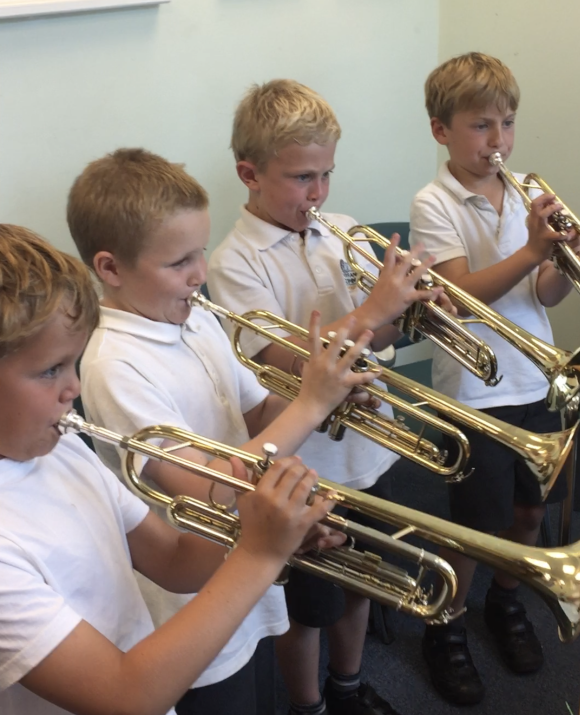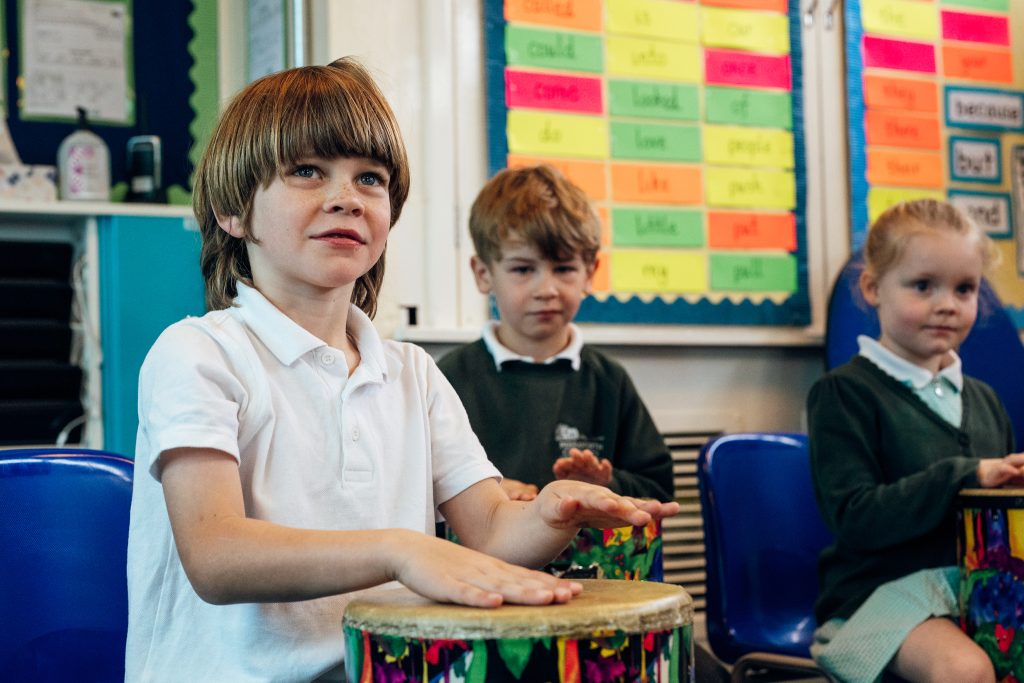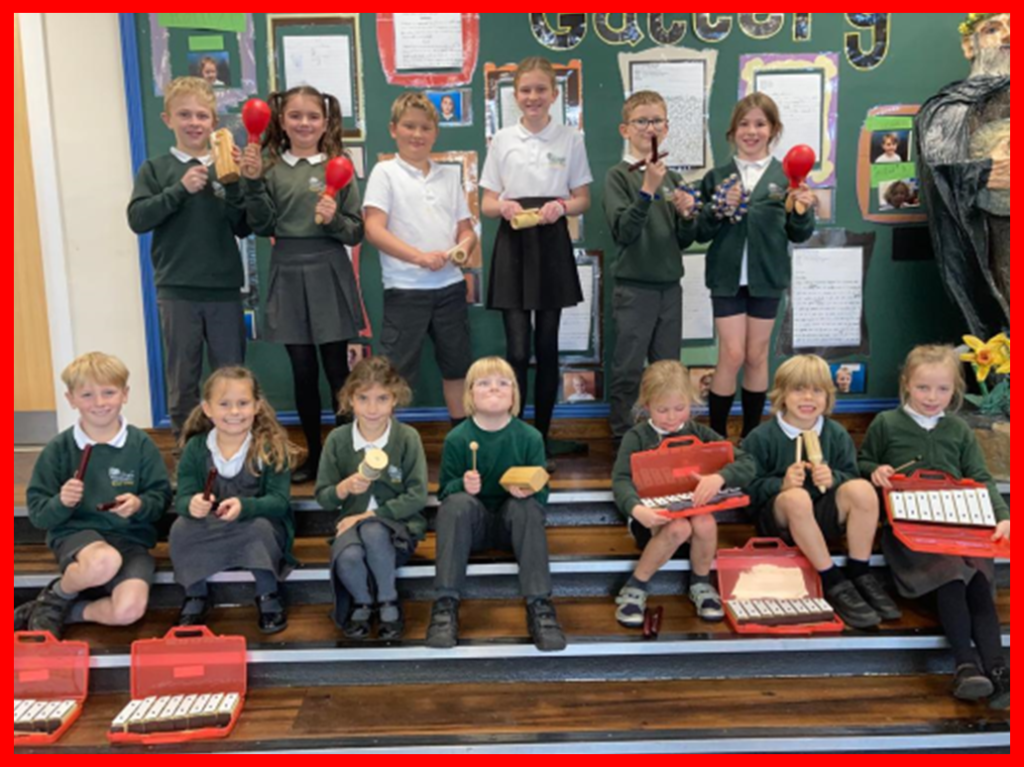Intent
At Perranporth School, we aim to give children a variety of musical experiences that create memorable moments where teachers and children of all abilities can participate.

We work with our local music services to ensure every child has the opportunity of learning to play a ukulele and a recorder during their time at Perranporth. There are further opportunities for children to learn how to play a musical instrument with a peripatetic teacher if they choose. Currently these teachers offer guitar, keyboard and brass instruments.
Through engagement in class lessons, live musical performances, singing assemblies, performances, recorder, ukulele clubs and choir we want children at Perranporth School to experience ‘musical joy’ in as many ways as possible. They listen to and sing a variety of songs from different times or genres and compose their own ideas with their own notation because all efforts are valued.
Our children take part in musical performances throughout the year. They can sing or play solo if they would like to. Children at Perranporth can describe the music they hear or play, using appropriate musical vocabulary.
Teaching World Music is very important to us, as living in Cornwall means our children are less exposed to different cultures. In addition, we are very proud of our Cornish heritage and celebrate this enthusiastically on St Piran’s Day in March!
Implementation
Teachers use the National curriculum and the Music Model Curriculum (MMC) as a starting point for their lessons. In addition, a music scheme called ‘Charanga’ provides teachers with a valuable resource with which to deliver their lessons. Perranporth music lessons consist of four parts, as outlined in the MMC. They are musicianship, listening, singing and composing/performing.
Foundation stage
In their Reception year, children learn songs and rhymes with actions to develop musical skills. They perform songs in the local church at Harvest time and for their class nativity at Christmas. They perform with the whole school on St Piran’s Day in March. In addition, children listen to world music from India, as part of their Divali celebrations and African drumming as part of their learning about Handa’s surprise. They use words like long, short, fast and slow to describe Jack climbing up and down the beanstalk and choose instruments to compose sounds as part of their ‘Starry night’ project. Sometimes they make marks or pictures to show them when to perform a sound.
Key stages 1 and 2
Musicianship
Children practise rhythm, pitch, dynamics, tempo or steady beat. These are known as our ‘golden threads’ in Music because they are integral to all other musical learning.
Listening
Children listen to music from a variety of times or genres in their class lessons and identify key features of music they hear using musical vocabulary.
As children enter the hall for assembly, they listen to music. They are signposted towards a poster showing the image and additional information about the composer.
Children hear live music during their time at our school. During the summer term (and in honour of World Music Day), we invite live performers into school once a week to share their particular genre, for example, A Samba band, folk band or brass quartet.
Singing
Children sing regularly at our school. We have a school song with lyrics about our GREEN curriculum that is familiar to all of us. At our weekly singing practice, we learn new songs for pleasure or for whole school performances. As well as this, children learn songs related to their class topic, for example, in Year 1 the children will learn to sing London’s burning as part of their London theme and Year 5 will learn ‘It’s a long way to Tipperary’ in harmony with ‘Pack up your troubles in your old kit bag’ when their topic is ‘World War 2’. Children learn to sing rounds in Year 4, 2-part harmony in Year 5 and 4-part harmony in Year 6.

Next year our children will take part in SONGFEST, working in conjunction with our local Music Hub to perform songs with other schools across Cornwall.
Composing and Performance
Each term children have an opportunity to compose using their voices, things around them or real instruments (pitched and unpitched). Usually, they will use a picture or poem as a stimulus for this. Children are encouraged to improvise too. Sometimes they use Music Apps such as Chrome Music or Garage Band to explore synthetic sounds. Children are taught to record their compositions in a variety of ways, for example, marks and pictures as well as formal notation in Keystage 2.
At the end of the Autumn Term, every child in the school will take part in a musical performance with their class or key stage as part of our Christmas celebrations. Prior to this, Reception and Year 1 classes will have performed at the local church for the Harvest. Children are all encouraged to become a ‘Star Performer’ where they can show off their musical skills to the whole school with a polished solo performance.
In addition, our school choir perform throughout the year to various audiences in our local community, for example, ‘Perran Bay’ residential home.
In March, the whole school leads a public performance on the village green to celebrate St Piran’s Day. At this event, they will perform three traditional pieces including the Cornish Hakka.
As well as these, children perform to other classes or parents to celebrate their achievements.
IT
Purple Mash 2 Simple
GarageBand
Chrome Music
Impact

Our Music Curriculum is high quality, well thought out and is planned to demonstrate progression.By the time they leave Perranporth School, children will have had many musical experiences and opportunities to learn new instruments. They will have gained key knowledge and skills in all areas of the Music curriculum but most importantly they will feel musical.
We measure the impact of our curriculum through the following methods:
For more information click here or email Mrs Green kgreen@perranporth.tpacademytrust.org
For more information about music in each year group see below